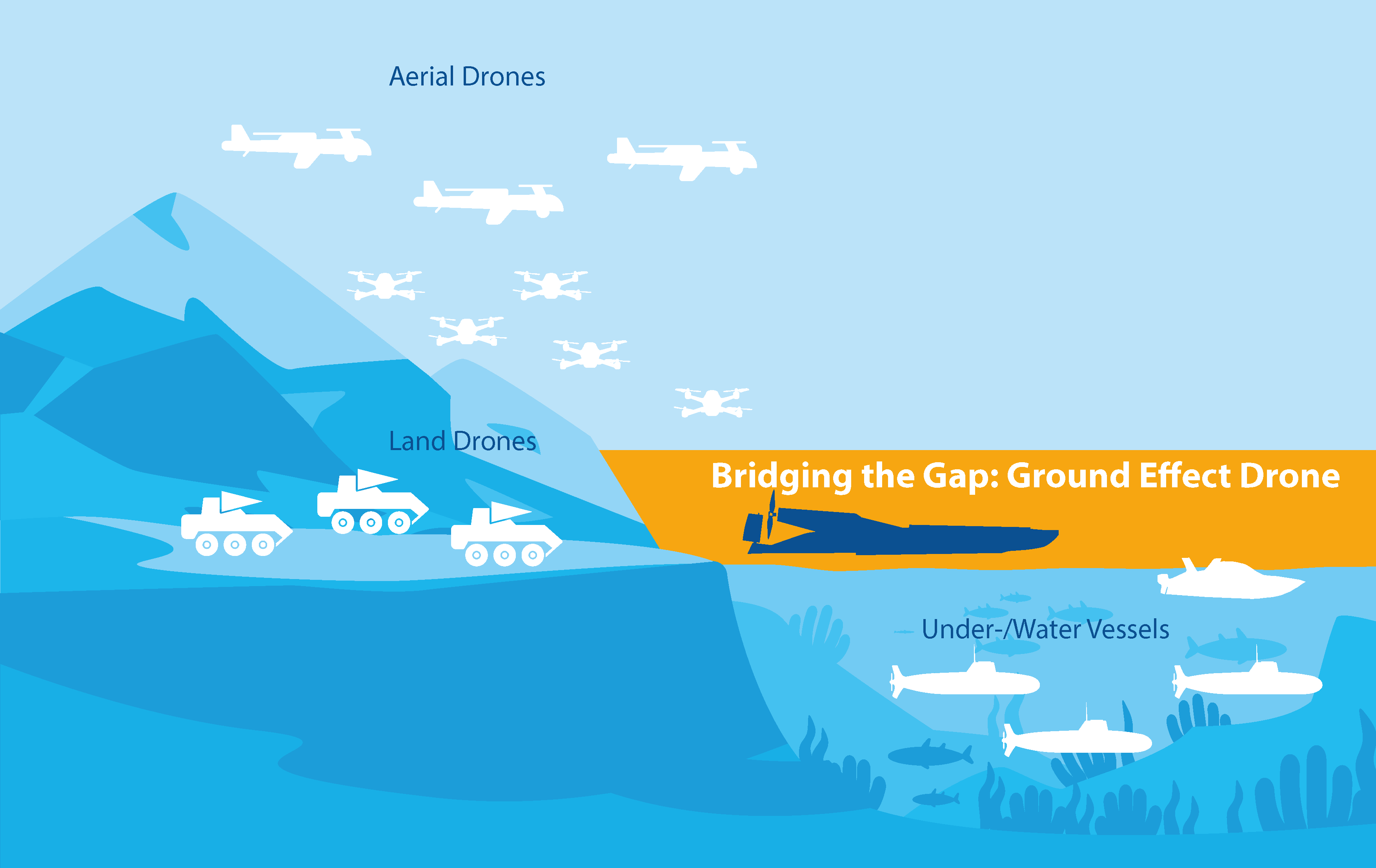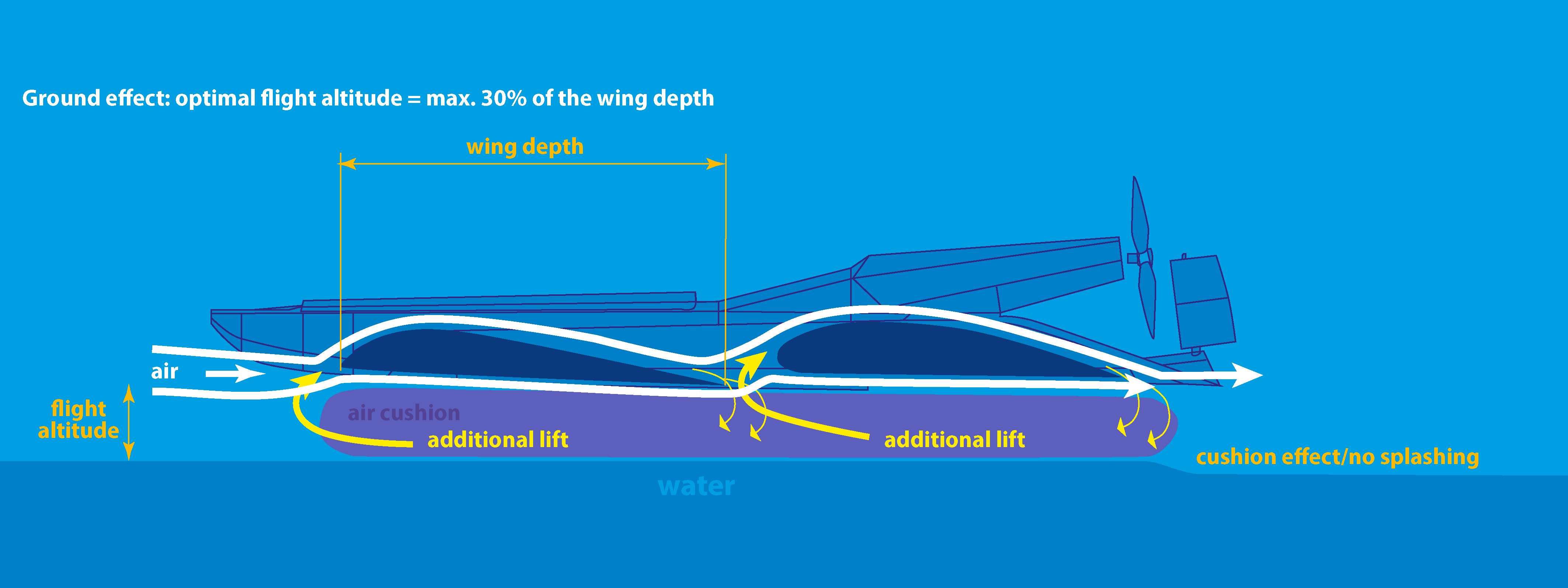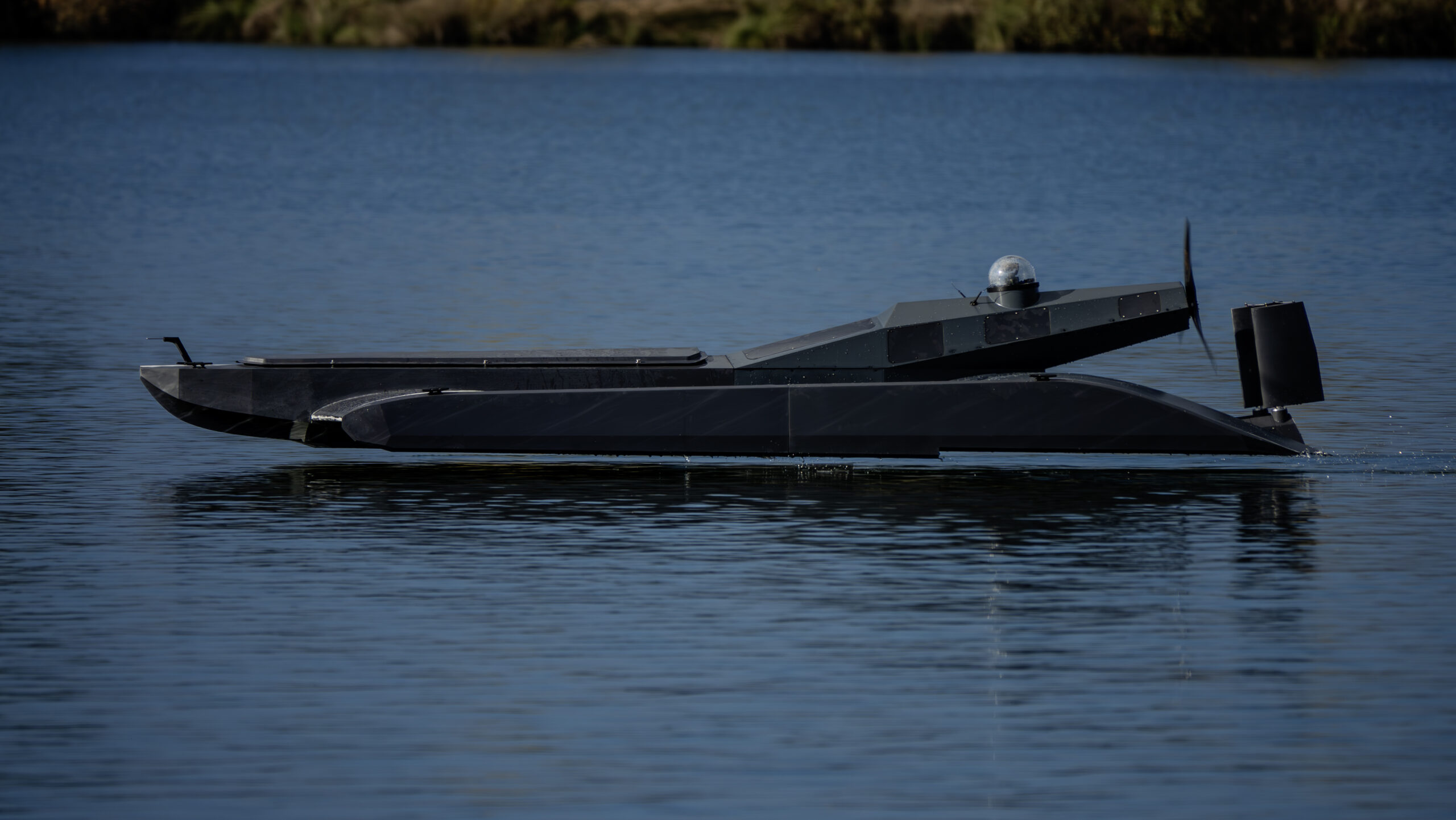
AWARD
Defence Innovation Pitch Day Munich 2025
We are proud to announce that our TW Cargo ground-effect drone won 2nd place at the Defence Innovation Pitch Day 2025!
Bridging the Gap
Tandairium introduces the world’s first true and modular ground effect vehicle (WIG craft) – unmanned or piloted.
Developed in Europe and based on the tandem airfoil principle pioneered by Günther Jörg, reengineered for the modern era by his son Reiner Jörg. Unlike hydrofoils or delta-wing concepts, it self-stabilizes entirely within the ground effect zone – flying faster than boats, more efficient than aircraft, and nearly undetectable to radar, sonar, or infrared. This dual-use vessel platform is a true gamechanger for defense, surveillance, logistics, research, passenger and cargo transport, and offshore operations. Scalable. Modular. Built in Europe. A revolutionary leap in maritime mobility.
Superiority, Speed, Sovereignty – they always prevail!

The Ground Effect Principle
Ground Effect Explained: Close-to-surface flight compresses air under the wing, forming a high-pressure air cushion (“ram effect”) that boosts lift.
More Lift, Less Angle: Wings in ground effect generate more lift with a lower angle of attack, increasing aerodynamic efficiency.
Reduced Drag: Ground proximity reduces wingtip vortices and induced drag, allowing smoother, faster, and more energy-efficient flight.
Natural Efficiency: Ground effect makes wings act as if they were larger – more lift, less energy, no additional fuel needed.
Stability Challenge: Other ground effect vehicles (GEVs) with single wings (Delta or Hydrofoils) were unstable and hard to control at low altitudes.
Tandem Airfoil Innovation: German engineer Günther Jörg solved this by designing the Tandem Airfoil Flairboat – a WIG craft with two wings in tandem for natural stability.
Balanced Flight: The tandem wing configuration distributes aerodynamic forces more evenly, enabling safe, controlled, and sustained ground effect flight.
Legacy of Innovation: The Jörg principle laid the foundation for today’s self-stabilizing modular ground effect drones, redefining maritime mobility and dual-use aerospace platforms.

„For over 50 years, the ground effect waited in the shadows of aviation — powerful, proven, yet overlooked. Today, we bring it to life. Not as a concept, but as a revolution in motion.“
Reiner Jörg | Son of Günther Jörg | CEO/CTO and Co-Founder of Tandairium GmbH
Innovation is our DNA
TandAIRium – the World’s First True Ground Effect Vehicles StartUp
At TandAIRium, we stand at the intersection of aerodynamics, innovation, and vision. Founded by Reiner Jörg, Dipl.-Ing., Tandairium is the continuation of a pioneering legacy — and a bold leap into the future.
Growing up surrounded by his father’s invention — the original Tandem Airfoil Flairboat, created by Günther Jörg — Reiner inherited not just an idea, but a lifelong fascination with flight just above the surface. Today, he has re-engineered and reimagined that vision for the 21st century.
With the development of the TW Drone and TWS Seats Series, Tandairium has introduced the world’s first true ground effect vehicles — a technological breakthrough redefining what’s possible in unmanned and manned low-altitude flight.
Unlike conventional aircraft, hydrofoils, delta wings, or hovercraft, our systems fly stably, efficiently, and autonomously mere centimeters above water or land — harnessing the wing-in-ground effect for unmatched stealth, speed, and payload performance.
Our mission is clear: to deliver game-changing aerial and maritime systems for defense, security, commercial mission sets and critical logistics — engineered in Germany, trusted worldwide.
At TandAIRium, we believe that real innovation doesn’t just improve the present —
it reshapes the future.

Defense
USP: Stealth and Tactical Mobility
Superiority, Speed, Sovereignty – they always prevail!
TandAIRium’s TW Drone Series is engineered for modern defense — a stealth ground-effect UAV that bridges the gap between air and sea operations, redefining tactical mobility and surveillance.
TW Drone Series
> Very low radar signature (Stealth)
> Low noise signature
> No sonar detection during flight
> Almost no thermal signature
> Cost- and time-efficient production in Europe
> Technological advantage, easy operation
> Payload: 40 kg – 1000 kg
> Speed: 105 km/h up to 200 km/h
> Range: up to 1000 km
Mission Sets
> Defence
> Reconnaissance
> Coastal surveillance
> Rescue missions
> Transport / Cargo
> Surveying
> Scientific missions
> Governmental tasks

Commercial | Civil
Advantages of our WIG Vehicles
TandAIRium is redefining the future of maritime mobility — where sustainable innovation, cutting-edge aerodynamics, and speed converge to create the next generation of eco-efficient transport.
TWS Seats Series
> Unforgettable Experiences:
Exclusive coastal and inland journeys aboard the world’s first true Wing-in-Ground (WIG) craft — combining technology, comfort, and adventure.
> Effortless Handling:
Intuitive operation and outstanding performance — just a boat licence required, just pure freedom on water and coast.
> Speed Meets Comfort:
Cruise at aircraft-like speed with yacht-level comfort — smooth, quiet, and uncompromisingly refined.
> Eco-Luxury Mobility:
A new class of sustainable lifestyle vehicles for the modern, environmentally conscious traveller.
> Leisure Redefined:
Enjoyment meets responsibility — explore nature with minimal environmental impact and maximum innovation.
> Green Tourism Advantage:
Ideal for operators and resorts seeking eco-friendly maritime mobility with low emissions and low operating costs.
> Unique Technology:
Tandem-wing ground-effect design — a patented innovation, engineered in Germany, unmatched worldwide.
Mission Sets
> Coastal & Island Transport:
Fast, efficient passenger shuttles connecting harbours, islands, and resorts — replacing slow ferries and reducing CO₂ emissions.
> Eco-Tourism & Charter Operations:
Premium WIG craft for private tours, adventure travel, and luxury coastal experiences.
> Corporate & VIP Mobility:
Exclusive transport solutions for executive transfers, island resorts, and maritime events.
> Offshore & Industrial Logistics:
Reliable crew-transfer and supply missions to offshore wind farms, platforms, and ships — faster, safer, and weather-resilient.
> Emergency & Rescue Operations:
Rapid-response mobility close to the surface — reaching disaster zones or maritime incidents when helicopters and boats cannot.
> Public Service & Research:
Ideal for coast guard, environmental monitoring, and scientific exploration — silent, efficient, and low-impact.
WIG Series | Product Ranges
01
TW Drone
TW 4 | TW 8 | TW 11 | TW 14
The TW Drone Series is a modular, unmanned ground effect drone – engineered for maximum payload efficiency and versatile multi-mission capabilities.
Built on an ultra-light tandem wing platform, it achieves an exceptional payload-to-empty-weight ratio: up to 90% of its structural weight can be used for cargo or mission-specific payloads.
Flying consistently within the aerodynamic ground effect – just above the water surface – the system combines high lift with minimal drag, enabling energy-efficient, low-signature operations.
Depending on the model size, the drone covers ranges from 60 km (TW4 Drone) up to 1000 km (TW14 Drone) and can handle wave heights from 40 cm (TW4 Drone) to 1.34 m (TW14 Drone). When conditions exceed flight limits, the drone seamlessly transitions into watercraft mode.
Designed for real-world deployment, the TW Drone Series features intuitive FPV control, rapid setup, and maintenance-friendly construction. Manufactured in Europe, it offers fast modular reconfiguration for a broad range of use cases – from defense and logistics to research, environmental monitoring, and civil protection.
This new generation of unmanned ground effect vehicles redefines maritime mobility: scalable, efficient, and technologically sovereign.

02
TWS Seats
TWS 2 | TWS 4 | TWS 8 | TWS 23
The TWS Seats Series is a modular, piloted ground effect vehicle designed for high-speed, efficient, and comfortable passenger transport over water.
Based on the self-stabilizing tandem wing principle, this Wing-in-Ground Effect Craft (Type A) flies just above the water surface, harnessing aerodynamic lift and dramatically reducing drag. The result: significantly lower fuel consumption, higher cruise speed, and smoother ride comfort – even in moderate wave conditions.
Thanks to its classification as a Type A WIG craft, operation requires only a standard boat license. No specialized runways or infrastructure are needed – the craft can take off and land directly from conventional harbors, beaches, or floating platforms.
The TWS Seats Series is ideal for a wide range of civil and commercial applications: from fast water taxis and commuter transport to emergency evacuation, offshore personnel transfer, and sustainable maritime tourism.
Manufactured in Europe and built for scalable deployment, the TWS Seats Series redefines coastal mobility – fast, fuel-efficient, infrastructure-light, and ready for the maritime challenges of tomorrow.

Gallery of TW4 Drone
Explore the world’s first true ground effect drone in action. From early prototypes to live test flights, our gallery offers a glimpse into the design, innovation, and performance behind the TW4 Drone. See how engineering meets elegance — just inches above the surface.
Successful Prototype and Scalable Platform
Various Mission Sets
The prototype with a wingspan of approximately 4 meters (TW4 Drone) has already been built and successfully tested in real-world flight trials. This fully functional demonstration model proves the feasibility of the visionary concept. Despite its compact dimensions, the prototype has already demonstrated impressive performance, carrying payloads of up to 37 kg with operational ranges reaching 60 km. These figures – achieved with a whisper-quiet 8 kW electric drive – underline the remarkable potential of the platform.
At the same time, the drone is built on a modular architecture: fuselage and wings can be adapted to various payload requirements, and the vehicle can be equipped with cameras, sensor arrays or other mission-specific modules. This scalable platform approach enables the development of future variants in different sizes or specializations – without having to reinvent the basic design. The story of the TW4 Cargo demonstrates one thing clearly: this technology is ready for deployment and can now be scaled for industrial production. What began as a bold idea has rapidly evolved into a tangible high-tech product – a solid foundation for further series development and growth.
Versatile Applications: Defense, Security, Research, and Logistics
The ground effect drone is a true multi-mission platform, addressing a wide range of operational needs – a key factor in its strong market potential. Particularly in the military and security sectors, it delivers new capabilities that conventional UAVs simply cannot offer:
Defense & Coastal Protection: This UAV serves as a near-invisible reconnaissance and patrol asset along coastlines, borders, or operational zones. Thanks to its ultra-low signatures, it can also be used in kamikaze missions or as loitering munition, striking high-value targets with precision and surprise, before enemy defenses can respond.
Surveillance & Security: For police forces, border patrol or intelligence services, the drone enables silent and unobtrusive surveillance over land and water. Critical infrastructure and expansive zones (ports, offshore facilities) can be continuously monitored – without drawing attention.
Rescue Operations & Disaster Relief: In humanitarian missions, the drone can operate in dangerous or hard-to-reach areas – for instance, locating shipwreck victims just above the water’s surface or delivering vital supplies after natural disasters. Its ground effect flight enables stable low-altitude missions even in adverse weather, where helicopters or boats may fail.
Science & Logistics: Beyond defense, the platform is highly attractive for civilian use. In environmental research, it enables silent overflight of ecosystems, gathering data on wildlife or habitats without disturbing nature. In logistics, multiple units can form a rapid drone network, transporting spare parts or medical supplies between coastal cities and offshore platforms – faster and more energy-efficient than boats.
This wide range of use cases demonstrates how market-oriented and adaptable the ground effect drone truly is. Unlike specialized drones built for a single purpose, this modular platform can be configured for diverse roles. As a result, it simultaneously addresses multiple high-growth markets – from defense and civil security to next-generation logistics – maximizing its commercial potential.
Unseen | Unmatched | Unstoppable
Unique Concept: Flying in Ground Effect
This groundbreaking drone is the first unmanned aerial vehicle (UAV) to fully harness the ground effect principle — a concept previously seen only in experimental seaplanes. When flying just above a surface (land or water), the drone benefits from significantly enhanced aerodynamics: even at an altitude of only 5% of its wingspan, flight efficiency increases by a factor of 2.3.
The result? Extremely low detectability across all domains. Operating just a few decimeters above the ground or water, the UAV flies below conventional radar coverage — making it visible to enemy sensors only at the last moment. The stealth advantage extends further: equipped with electric propulsion, it produces virtually no engine noise and emits minimal thermal radiation. Even sonar systems are ineffective, as the drone glides contact-free just above the surface.
This unique profile — neither a conventional aircraft, nor a boat, nor a land vehicle — defines an entirely new category of unmanned system. It breaks through existing limitations and opens operational possibilities that traditional drones cannot achieve. Comparable technologies, such as low-flying cruise missiles („sea skimmers“), have already proven how effective ultra-low altitudes are at evading detection.
But until now, no unmanned system in the world has been capable of sustained flight in ground effect. This drone is the first of its kind.
Seeking Visionary Investment Partners
Be Part of the Future of Maritime Mobility
Invest in the Future of Maritime Mobility
Tandairium is pioneering a new category of WIG (wings in ground effect) systems: modular, high-payload ground effect drones and WIG passenger craft. Engineered in Germany and based on the patented tandem airfoil principle, our vehicles fly just above the water surface – combining high speed, ultra-low energy consumption, and stealth capabilities.
Dual-use platform: Defense, surveillance, logistics, rescue, travel, and research
High payload efficiency: Up to 90% of empty weight as payload
Scalable range: From 60 km to 1000 km, over waves up to 1.34 m
No runway needed: Operates from harbors and coasts
Made in Europe: Lightweight, modular, infrastructure-free
Growing market: Global drone and WIG craft sectors > $220 B by 2034
From autonomous cargo drones to high-speed water taxis, Tandairium bridges sea and sky. We are now seeking visionary partners to scale production and bring this disruptive mobility to market.
Shape the future of sovereign, sustainable maritime transport – with us.
Revolutionary UAV Technology, Made in Germany
Tandairium’s TW Drone and TWS Seats Series iare the world’s first true Wing-in-Ground (WIG) system — a breakthrough in low-altitude, high-efficiency flight just above land or water.
The successful prototype (≈ 4 m wingspan) carries up to 40 kg payload over 60 km – a proven demonstration of stable, energy-efficient hover flight in ground effect.
Powered by tandem-wing technology, the drone maintains autonomous flight only 20–40 cm above the surface, maximizing lift while cutting drag in half.
This ultra-low profile grants stealth characteristics: minimal radar and heat signature, silent electric propulsion, and no sonar echo — ideal for covert missions and maritime surveillance.
The modular architecture supports various payloads (cameras, sensors, logistics modules) and is scalable — future versions with greater span could carry payloads up to one tonne.
Revolutionary WIG Passenger Craft
Beyond drones, Tandairium develops manned Wing-in-Ground (WIG) craft for fast, comfortable passenger and cargo transport.
The TWS Seats Series (2, 4, 8 – 23 seats) offers modular ground-effect gliders for coastal and inter-island travel.
Classified as WIG Type A, they operate directly from ports, beaches, or offshore platforms — no airports or runways required.
Operation requires only a boat license, not a pilot’s license, drastically reducing entry barriers.
Thanks to tandem-wing aerodynamics, these craft achieve ~50 % fuel savings with cruise speeds around 100 km/h, combining efficiency, comfort, and sustainability.
High-Growth Applications
• Logistics & Cargo:
The drone-logistics market is set to soar from ~$1.2 B (2023) to $13.5 B by 2031 (≈35 % CAGR).
WIG cargo drones bridge coastal, island, and offshore zones faster than ships and far cheaper than helicopters. Ideal for time-critical missions (medical, spare parts, offshore supply) and eco-sensitive zones thanks to quiet, zero-wake operation.
• Passenger Transport:
WIG ferries redefine regional mobility — up to 3× faster than traditional vessels, with minimal wave impact and airplane-like comfort.
The market is forecast to grow from $325 M (2024) to $2.1 B by 2033.
By leveraging waterways, WIG craft bypass airspace restrictions and outperform eVTOLs in payload and range — a game-changer for coastal and lake transport.
• Offshore Operations:
The offshore energy sector is expanding six-fold by 2030.
WIG vehicles enable rapid crew transfer, emergency response, and supply missions — weather-resilient, fast, and independent of harbor infrastructure.
They can reach turbines or rigs where helicopters and boats fail.
• Defense & Security:
The defense-drone market will expand from ~$25 B (2024) to $74 B (2032).
Armed forces seek low-detectability, high-endurance platforms for coastal surveillance, reconnaissance, and precision delivery.
As “sea-skimmers,” Tandairium UAVs fly missile-like trajectories just above the surface — evading radar and early detection.
Projects like DARPA’s Liberty Lifter and China’s Bohai Sea Monster show global momentum in this field — Tandairium is Europe’s answer.
European Advantage
With Europe investing billions into drone sovereignty, Tandairium’s German-engineered WIG drone represents a strategic alternative to U.S. and Asian systems.
Its dual-use strategy (defense + civil) unlocks public funding and commercial revenue — a rare multiplier for growth and resilience.
Investment Case
First-Mover Advantage: proprietary tandem-wing technology in a high-barrier niche.
Scalable business model: UAVs → cargo → passenger → defense.
Aligned with megatrends: defense modernization, drone logistics, and green maritime mobility.
Made in Germany: engineering excellence and EU-tech sovereignty.
Why Choose Us
Strategic Advantage: European Independence and Technological Leadership
Beyond its technological strength, this project offers a critical additional asset: it is a high-tech innovation made in Germany — and therefore independent of U.S. or Asian technologies. At a time of rising geopolitical tensions, European governments are placing increasing emphasis on technological sovereignty in security-critical systems. Indeed, the EU is currently investing billions to ensure defense readiness and independence in the drone sector.
A ground effect drone developed and manufactured in Germany fits seamlessly into this strategy. It offers European armed forces and government agencies a trusted alternative to U.S. systems (often restricted by export controls) and to Asian models (which raise dependency or cybersecurity concerns). Expertise and value creation remain in Europe — a factor that aligns with political priorities and enhances eligibility for funding and procurement programs.
For investors, this represents access to a strategic and rapidly evolving market where Western nations are actively seeking reliable, homegrown partners. With its unique positioning — as the pioneer of an entirely new DroneTech category built on European engineering — this startup has the potential to become a technology leader.
This ground effect drone is poised not only to disrupt the global drone market, but to help define Europe’s role in the next generation of unmanned systems.
The message to venture capital is clear: this is a truly singular opportunity — a patent-worthy innovation with proven proof-of-concept, exceptional scalability, and global market relevance — ready to lift off and set new standards in the drone industry.
Our team
Our team combines engineering excellence, visionary thinking, and decades of experience to shape the future of unmanned or piloted ground effect flight — with passion, precision, and purpose.

Dipl.-Ing. Reiner A. Jörg
CEO/CTO and Co-Founder
Reiner Jörg is the visionary CTO and co-founder of Tandairium GmbH, drawing on over 30 years of executive engineering leadership across precision machine tool development and aerospace innovation. As the inventor’s son, he reengineered the Tandem Airfoil Ground Effect Vehicle into a next-generation modular platform for defense and dual-use maritime applications. With deep expertise in aerodynamics, systems integration, and manufacturing strategy, Reiner leads R&D, platform architecture, and international technology positioning for Tandairium’s groundbreaking WIG craft.

Guido Steinbach
CFO and Co-Founder
Guido Steinbach, CFO and Co-Founder of TandAIRium, is a seasoned financial leader with decades of experience guiding innovative and dual-use technology ventures. He combines robust financial acumen with a strategic mindset, aligning TandAIRium’s fiscal strategy with its cutting-edge vision and ensuring sustainable growth while instilling confidence among stakeholders.

Dipl.-Ing. Sebastian Hilberg
Business Development
Sebastian Hilberg leads strategic business development at Tandairium GmbH. He combines deep technical insight and expertise — gained from following Günther Jörg’s early innovations — with a strong focus on dual-use commercialization and international partnerships. He drives market strategy and positioning for Tandairium’s modular ground effect platforms.

Dipl.-Des. Kerstin Heinlein
Communication and Design
Kerstin Heinlein is Head of Communication and Brand Design at Tandairium GmbH. A trained communication designer with over 25 years of experience, she shapes the company’s visual identity, storytelling, and content strategy. Deeply familiar with the work of Günther and Reiner Jörg, she brings a unique perspective that merges engineering vision with design excellence— turning complex technology into compelling narratives and strong brand presence.
Contact us
We’d love to hear from you. Whether you’re looking for more information, a detailed presentation, or would like to schedule a live demonstration of the TW4 cargo, our team is here to connect.
Let’s explore how ground effect technology can shape the future — together.
Reach out to start the conversation, exchange ideas, or arrange a meeting.
